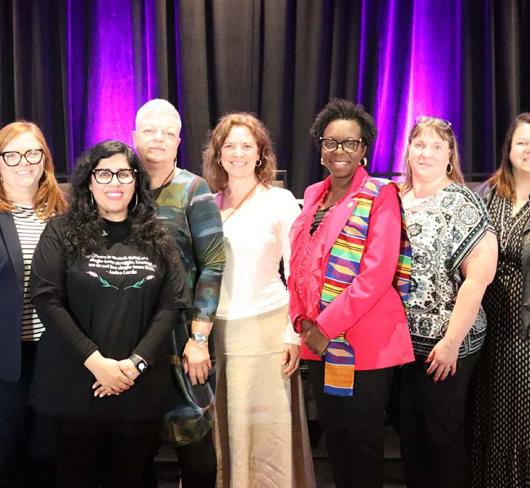Advice from Our Grandmothers: Teaching and Learning During a Global Pandemic
Crisis Teaching
In mid-March, we were suddenly glued to the news. The government abruptly announced it was closing public schools, closing borders and asking people across the country to stay home. As educators, we waited to find out what this meant for students. We knew our students needed their classrooms for more than just their education, and we worried for them. In consultation with ETFO and other stakeholders, the Ministry provided parents and school boards with online learning directives following the March break closures. The entire province was thrown into a whirlwind of emergency distance learning. Bracing for what was yet to come, we held our families close. The provincial state of emergency was extended several times by the premier, and as I write this article, I have no idea whether we will return to school at all this year. Teaching and learning during a global pandemic in the 21st century is unknown territory for everyone. How do we move forward in these uncertain times and what might our future look like?
Educators have jumped into the deep end, head-first. We are committed to our students and we know the importance of school in their lives. Board-directed inventories of classroom technology emerged and parents were surveyed to ensure they had a device and access to the internet. Inequity loomed as it became increasingly clear that many did not. Not only were many parents struggling with food security, childcare, job loss, health issues, working from home full time, grief and panic, they suddenly had to learn a new platform and help their children with distance learning. Some parents had to learn several new platforms depending on how many children they had. That alone required patience, technical knowledge and expensive devices. Many of our own members experienced the same issues.
Drawing from a History of Resilience
As an Indigenous woman, mom and educator, I have felt the need to take a moment to pause and reflect. How do I take lessons of resiliency from our ancestors or the women in my community, and apply them in this moment? What is the legacy I want to leave for my students? If this were any other situation, I would turn to the grandmothers for their insight and wisdom about how to keep going in times of adversity. What would they do?
I think about the late Elsie Knott from Curve Lake First Nation. She was the first female band council chief in Canada, from the community in which I grew up. What did she do when they had no bus to get the kids to school back in the day? She bought a hearse and drove them to the school in town herself. Through a cloud of oppression, she remained resilient and a role model for the rest of us.
Many grandmothers have not seen something exactly like this pandemic, but smaller epidemics have been part of their lives. Smallpox. Scarlet fever. Polio. Many northern communities still struggle with tuberculosis, food insecurity, boil-water advisories and access to education.
I think of the late Shannen Koostachin, a young social justice warrior who brought national attention to her cause, her community’s need for a school. Shannen’s Dream is an essential read for elementary students.
I think back to Maria Montessori, a woman and educator who broke gender barriers, advocated for students with special needs, changed the face of education and influenced the way our youngest students learn through play. Playing is learning, and children don’t need technology to play and learn. ETFO’s resource, “Engaging Children Through Play,” is an excellent resource for framing play through an Indigenous perspective in the classroom.
I think about the grandmothers and Ojibwe language teachers from the communities I have taught in. They remind us that everything we need to know in life, we learn from the earth. Our histories and cultures are embedded in Indigenous languages, and these women kept our languages alive even when it wasn’t safe to do so. They kept the teachings from the earth alive.
I think about Alanis Obomsawin, a filmmaker who, in her 80s, is still bringing us documentaries about the education, mis-education and rights of Indigenous children and peoples in Canada. With the ancestors behind her, she uses storytelling and media to shine light on challenging issues. The National Film Board of Canada has over 300 Indigenous films made by Indigenous film makers in the Indigenous Cinema Gallery and the CAMPUS learning platform is currently free for educators.
What do they all have in common? They relied on the support of their community. They employed critical thinking in times of crisis. They explored local social justice issues in their global context. They faced criticism and experienced push-back. Yet, they were resilient. They never gave up. They created change.
As we are faced with emergency online teaching, how do we breathe life into these fundamental concepts, now, and when we return to the classroom? If this is an opportunity to do things differently moving forward, what can we change?
From Crisis to Creativity
On pandemic day 25, my husband sent me a video link to Jon Corbin, a hip-hop, spoken-word artist and teacher from Milton, Ontario. He spoke about the challenges in his home as a parent. He spoke about reframing ways of thinking to a more holistic view of the child. He spoke about his passion for hip-hop and his need to spark creativity in his students and his own children. Corbin identifies five simple things that might help us all through our distance learning journey, keeping the concept of sparking creativity at the forefront.
Five ways to re-frame distance learning for educators and parents:
- Have a plan. Co-create a schedule. Help kids know what to expect. Set expectations for “learning.” The learning goal is for children to create more than they consume. Could we facilitate a balance between academics and creating?
- Observe their motivation. Pay attention to what they like. What are their interests? What excites them? What have they always wanted to try but were maybe too nervous to? Talk about it with them. Cultivate their creativity through conversation.
- Find resources. What can be found around the house or online that will support their interests and creativity?
- Give ownership to the children. Let the kids decide what they want to create. Can they decide on a project and follow through on it?
- Encourage sharing. Is there a time each week that could be set aside to share with each other? Maybe share with family through mail, or online with peers. The sharing circle, in all grades, was one of my students’ favorite times of the week.
Moving Forward
I think back to a time in my life when I was living in a remote First Nation and struggling with patience as a new teacher and the mother of a young child. I sought the advice of an elder, a grandmother in the community. Elders often have a beautiful way of answering questions through storytelling. She talked to me about how women traditionally raised and taught their children. She told me that I should treat my daughter and my students as if they were guests in my home. And this small piece of advice has been the single most important life lesson I have ever embedded in my personal and professional life. As Paulo Freire wrote in Pedagogy of the Oppressed, “every time you open your mouth, you either oppress or you liberate.” Author Peggy O’Mara said “the way we talk to children becomes their inner voice.”
Quotes like this remind me of the teachings I received from our Elders, passed down by our ancestors. Love, kindness, bravery, courage, humility, honesty and wisdom. Teachings in life which resonate with a holistic view of the child and their education.
Moving forward, I hope that during this pandemic time, we remember what is truly important. Keeping the spirits of our young ones shining should be our goal. Nurturing their creative souls in addition to creating a community of learners remains imperative. Encouraging them to get outside safely while social-distancing to connect with the earth and all her bounty is a necessary part of everyday life for our students. There are many online resources that support these activities.
As the province prepares for a what if we don’t go back to the classroom until it’s safe to do so, educators continue on the frontlines of online emergency education. I guarantee our students won’t remember much of the information we transmit through the new 5G waves. What they will remember is the relationships we build with them, how we speak to them and how we support them. We have an opportunity to return to the teachings from our grandmothers and focus on relationship-based education.
Tanya C. Leary is a member of the Hamilton-Wentworth Teacher Local.

